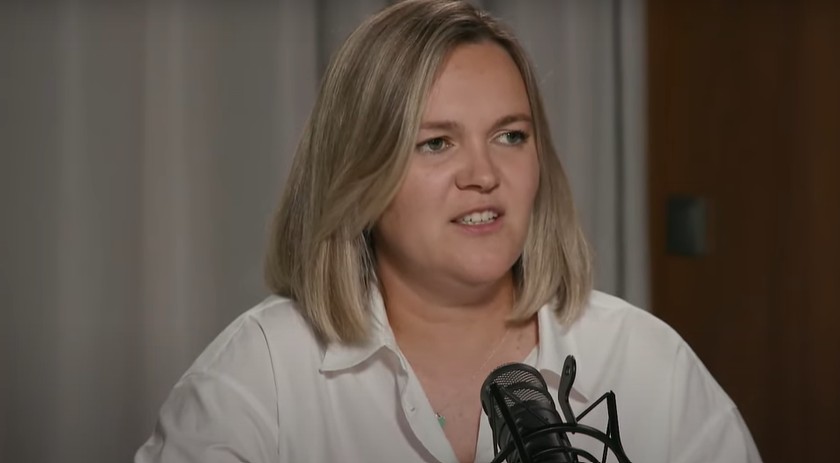IM_Ep 114_What is normal anyway?
PDF
Page 6 of 7
Sonia Thompson shared this file. Want to do more with it?
IM_Ep 114_What is normal anyway?.pdf
1
What is normal anyway?
What does it mean to be normal, really?
Is it something we should all aspire to, something we should avoid, or is it really just a false construct
that we’ve all been conditioned to believe is true?
In this episode, we’re gonna get into the ins and outs of, quote, unquote, normal as it relates
to
consumers and the way it shows up in society, the way it shows up in marketing, and how we should
be thinking about and considering it when it comes to our inclusive marketing efforts.
Lots to come after this short break.
Okay. So we see a lot of advi
ce and quotes floating around in all kinds of places from all different
sources, and it all goes something like this. Let me know if you’ve heard any of these phrases.
Don’t be like anyone else or this one. No one ever made a difference being like everyon
e else or
this one, which is much more direct. Don’t be basic.
And when we look at the types of things that society rewards, it’s easy to understand why these
sayings are out there.
Look at athletes, the best athletes in the world, those that are househol
d names like Simone Biles,
Michael Phelps, Michael Jordan, Serena Williams, Lebron James, Lionel Messi, and Usain Bolt,
These folks are anything but basic or like anyone else.
Even if we look at people in work, leaders are often looking to award and prop
up top performers.
People who go above and beyond that perform at a high level at a level that is above that of their
peers.
Even look at the names we hear about in business and entertainment all the time. Names like Gary
Vaynerchuk, Elon Musk, Beyonce, T
aylor Swift, and Rihanna. So on one end of the spectrum, we
reward, we talk about, and kind of look up to and elevate people in certain contexts that are not,
quote, unquote, normal or clearly not like the rest of us when it comes to their abilities and re
cognize
accomplishments. In this sense, not being normal is desirable and a great thing.
And then on the other end of the spectrum are people who just want to be, quote, unquote, normal.
I’ve talked several times about how sometimes people who are differen
t don’t want to feel or be
different. I remember some years back, I had a colonoscopy.
Hopefully, that isn’t too much TMI for you. And I remember being thrilled when afterwards, the doctor
came back and told me my colon was unremarkable.
There was nothin
g noteworthy or out of the ordinary, and that was music to my ears because, in this
case, having something noteworthy could have meant a whole lot of health challenges. No bueno.
So when I go to a restaurant, sometimes I just wanna feel normal whe
n it com
es to the food options.
I hate having to be the person who has to ask all the questions and have the special requirements.
IM_Ep 114_What is normal anyway?.pdf
2
Do a quick search on Reddit, and you’ll see plenty of posts with people expressing their desire to
be, quote, unquote, normal, and sharing about all the ways they feel different from other people how
it makes them feel, and how it makes them feel isn’t goo
d.
Normal seems to be a spectrum, and where people fall on that spectrum seems to vary by situation.
So we’ve got exceptional on one end, clearly, people who are not like others and are celebrated for
it. Then on the other end, we’ve got people who feel d
ifferent from everyone else and just want to
feel normal.
They want to fit in. They want to be basic because for them the consequences and emotional toll
of
not being like everyone else is too much of a burden, but this whole thing is kind of confusing. D
o
we wanna be basic or not? Ultimately, it comes down to this difference being a fact.
People are often okay with being different if they know there’s a reward for it. People are often not
okay with being different if they feel like there’s a perceived pun
ishment or negative consequences
associated with it. It’s a great thing to be gifted at your craft or the things that you do.
It’s not so good when you feel less than for showing up in a manner that is different from what is
considered to be normal. But t
his brings up another important question.
Who decides what normal is? It used to be that it was normal in a family for a husband and a father
to go to work and the wife and the mom to stay home and care for the kids and the household.
Income households w
ith no kids by home and care for the kids or even dual
–
income households
with no kids by choice, plenty of single
–
parent households, and even households with happily single
people with no kids. I saw a data point a few years ago that said that less than ha
lf of kids in the US
grew up in a household with 2 heterosexual parents in the home.
So if we think about data like this, what is normal? Is it a nontraditional household? Normal is fluid.
Doctor Lyudmila Prasilova is a psychology professor and author of t
he new book, The Canary Code,
a guide to neurodiversity, dignity, and intersectional belonging at work.
Lyudmila has been on this podcast twice before talking about neurodivergence in the workplace and
neurodivergence as a consumer. I will drop links to
both of those episodes in the show notes below
so you can listen if you haven’t done so already.
For your reference, those were episode number 57, neurodiversity at Work, how to Create a Culture
Where Everyone Thrives, and episode number 60, designing inc
lusive experiences for
neurodivergent consumers.
Alright. So Doctor Lyudmila’s book is fantastic. You should definitely check it out.
I’ll also link to it in the show notes for you. So in her book, The Canary Code, Lyudmila lays out
some definitions that
I find super interesting, including this one of neurotypical, which she’s written
as a person or people whose neurodevelopment falls within the range conventionally seen as typical
but prevailing cultural standards is enabled by their society for a given p
eriod.
Another definition in this category that caught my attention is that of neurodiversity, which in this
book is defined as a biological fact that there is a limitless variety in human neurodevelopment with
many neurotypes and individual differences.
IM_Ep 114_What is normal anyway?.pdf
3
Neurodiversity as a concept refers to the full range of variations in human cognition, emotion, and
perception. And this other definition of neurodivergent is a person or people whose neurological
development or functioning diverges from the range conve
ntionally seen as typical. That is dyslexic
or dyspraxic person may refer to themselves as neurodivergent.
As a neurodivergent person, a group of ADHDers or people with a specific phobia are groups of
neurodivergent people. Some use neurodistinct, neurosp
icy, and other creative variations of this
term.
So in the book, she went on to write this commentary that has struck me for months, months. It was
so good and so eye
–
opening. Here it is. She writes, if neurodiversity applies to everyone, is anyone
at all
neurotypical? Some believe that neurotypical does not exist.
That everyone is in some way neurodivergent. However, according to an autistic psychologist and
thought leader Nick Walker, this argument stems from the false assumption that neurotypical is jus
t
a synonym for normal.
The belief in quote
–
unquote normal minds and brains is associated with the medical pathology
paradigm and does not make sense from the neurodiversity paradigm perspective. Neurotypicality
is socially and culturally constructed.
Dom
inant cultures operating within the normal versus pathological paradigm create cultural
expectations of normativity. Hence, children and adults are repeatedly told to act normal and not be
weird.
The collective belief in normal creates an image to which p
eople are expected to conform or else. A
neurotypical person is 1, able to convincingly and reliably perform according to expectations of
neuronormative functioning throughout one’s life without unbearable suffering, and 2, chooses to
maintain their perfor
mance and comply with the standards of the dominant culture.
The reward for compliance with dominant standards or
neuronormativity
is a perception of normality
and consequently neurotypical privilege. The neurotypical brain may not exist, but the neurotyp
ical
privilege of conforming to
neuronormative
expectations without making
oneself sick does. Dang.
Dang.
Dang.
Every time I read it, that’s my response. So from Ludmila’s research and other research in this area,
this whole concept of normal is off and is
causing harm.
From a marketing standpoint, we’ve seen examples of brands moving away from using the word
normal because it causes harm. Unilever, which makes brands such as Dove, Vaseline, and Axe,
recognizes the power of words they use in their marketin
g.
And in 2021, announced that it was removing the word normal from all its beauty and personal care
packaging and advertising. This is a global and super serious undertaking. The decision to make
such a change was rooted in inclusion.
The company conduct
ed a research study of more than 10,000 people and found that more than
half of people thought that the beauty and personal care industry can make people feel excluded.
IM_Ep 114_What is normal anyway?.pdf
4
Further data from the study showed just how much power the beauty industry has in the way
consumers feel about themselves.
From the research, 6 in 10 people agreed the beauty industry creates a singular notion of who or
what is quote unquote normal, and 6
3% of people agreed not having the word normal on packaging
and in advertising would inspire people to feel more positive about the way they look. In addition to
removing the word normal from packaging and advertising, Unilever decided to double down on
wh
at they are calling positive beauty efforts.
And noting that more than 1,000,000,000 people use their products every day, the company
announced that they are taking the opportunity to embrace a new era of beauty, one that’s inclusive,
equitable, regenerat
ive, and positive.
In a statement, Unilever spokespeople gave more detail on how the brand intended to make positive
change. They said we are setting out to transform the systems that hold individuals back by
advocating new policies, laws, and social norm
s that will promote inclusion, health, and well
–
being
for all members of society.
Apart from that statement, I want to highlight that they are advocating for new social norms, implying
that what is considered to be normal can be changed.
From an inclusive
marketing ethics standpoint, the core premise is not to cause harm. And it seems
that in a lot of cases, this whole idea of normal causes harm to people who don’t fit into the
predetermined mold of what normal is.
So what’s a marketer to do?
I’m gonna c
over that by reframing your way of thinking about normal after this short break.
And by chance, if you haven’t listened to the episode on inclusive marketing ethics, I’ll drop a link to
that in the show notes for you. There’s a super important episode. Ep
isode number 97, Inclusive
Marketing Ethics.
Okay. So here’s my point of view.
I think we mistake a desire to be normal with the root of the desire, which is really to just belong. So
I think I’ve mentioned this to you before, but just in case I have it,
let’s go over it again.
Here’s my favorite definition of belonging. It comes from Chris Brogan’s book, The Freaks Shall
Inherit the Earth. Chris wrote fitting in often means shaving off your unique edges, hiding, and
masking what defines you,
and
discardi
ng any behaviors appearances
,
or images that prompt others
to question you or push away from you. In other words, and this is me talking, fitting in is all about
trying to be normal.
Back to the book. Chris wrote, that belonging is about finding that plac
e where you finally let out a
deep breath you had no idea you were holding and feeling with great certainty that the people around
you understand you.
Belonging is about being you and knowing that that is more than enough.
Here are
a couple of other
defini
tions for you to help bring everything together.
IM_Ep 114_What is normal anyway?.pdf
5
Inclusive marketing is all about acknowledging the many ways in which consumers are different,
intentionally choosing which of those identities your brand will serve, and then authentically
incorporating
consumers with those identities throughout all phases of your marketing mix. And just
in case you didn’t know, here’s a definition of diversity. It’s simply the presence of differences within
a given setting. Diversity is normal or a better way to say it i
s diversity is common. Which brings me
to my first point about what marketers should do, and that is
to
take care with terminology. Let’s not
call things normal such as behaviors or ways of operating, ways of thinking,
and
ways of being.
Let’s not call the
m normal if it will cause harm to someone for being labeled not normal if their
approach is something different from that. Let’s not call things normal
without
having a true
understanding of what is actually happening in the world, not just our own percept
ion of it.
For instance, according to the Takeout, most American households eat dinner between the hours
of 5:0:7 and 8:19 PM. Emma Haupp says that the average dinner time in the US is 6:22 PM. My
household eats dinner at 9 PM.
Does that make us not norm
al? When you consider my husband is Argentine and that in Argentina,
dinner time is between 8 and midnight then we are eating at a very common time by Argentine
standards. That’s why terminology and the words we use are so important. So let’s get better ab
out
the words we use.
Call things what they are. Dry skin, oily skin, fair skin, dark skin, sensitive skin, not normal skin, and
other skin. There’s a diversity of skin types, so let’s acknowledge that in the terminology we use. It’s
size 0, size 8, size 1
8, size 24, not normal size
and
size.
There’s a diversity of body sizes and types. So let’s acknowledge that in the terminology we use. If
you mean common, say common. If you mean standard, say standard.
If you mean average, say average. Terminology is im
portant. So just know that the use of the word
normal is setting you and the people on the receiving end of the term up for problems.
2nd consideration for marketers
about
this whole normal concept is that customer experience
matters.
Remember, customer
experience is the vehicle with which the people you serve feel included by
you or like they belong with you. So even if you go through all the effort of intentionally including
people from specific communities, if the customer experience
is
substandard or subpar, then it
serves to make people feel not normal or othered and absolutely like they don’t belong.
I’ve gone through my inclusive customer experience spectrum in a lot of detail in episode 93, the
inclusive marketing Spectrum. I’ll
drop a link to that in the show notes so you can access it easily.
But even with the best intentions, because remember, your intentions are never a marker for
success, It’s the way in which the end consumer feels that matters. But even with the best intent
ions,
if the experience you’re delivering makes it clear that someone is different or kind of makes them
feel penalized for being different, then you’re reinforcing the message you’re not normal.
So when I go to a restaurant when I have to ask for an alle
rgen
–
friendly menu or pay an extra $2.50
for a gluten
–
free bun, you’re sending the signal it’s better to be normal, or you’re reminding me that
I’m different from everyone else when there is no benefit to being different.
IM_Ep 114_What is normal anyway?.pdf
6
In this case, there’s a penalty
of $2.50. When a Spanish
–
speaking customer this is relevant to any
language, has to scroll down to the footer of your website to find the link for the Spanish language
version of the website.
The experience you’re delivering says, we value you and your ex
perience less because you’re
different. As a brand, you don’t wanna make people feel bad about their differences or make them
feel othered or less important or like a burden or a nuisance because of what makes them different.
Differences are common, so it
is important to deliver experiences with that in mind so as not to
deliver a less
–
than experience that makes people feel like they don’t belong with you.
That
brings me to the 3rd and last point that I have for you today is to remember that belonging is
t
he goal. When the people you serve feel like they belong with you, they will reward you with their
attention and their loyalty.
When they don’t, they will go off in search of another option that does make them feel that way, that
does make them feel like
they belong. So be intentional about everything that you do. Think about
all the identities of the consumers you’ve chosen to serve and ensure that everything you do
throughout your marketing mix sends the signal you belong here.
Whether that’s ensuring y
ou have adequate representation in your visual imagery,
or
having
products, services, and experiences that ensure not only that everyone can get what they need from
you, but also that everyone
achieves
success at the same rates. Make sure you’re evaluating
everything you do regularly to ensure you’re delivering that sense of belonging to everyone you
serve, not just those that society deems as, quote, unquote, normal.
That may mean audits of your marketing and customer experience, user testing with consume
rs
from different identities, and even a deep dive into your data to ensure that everyone you serve is
achieving success at the same rates no matter their identity.
Do what you gotta do to ensure you’re delivering belonging to everyone who encounters your
brand
no matter where they’re encountering it.
That’s it for today’s episode, but that doesn’t need to be the end of the conversation. Let’s continue
to chat about this whole concept of normal, what it means for you, how you feel about it, and how
you use
it in your brand or not. Let’s continue the conversation. Tag me on social. Send me an email.
Let’s have a chat in the DMs. I wanna hear what it is that you’re thinking and dialogue more on this
topic.
If you like this show, do share it with a friend,
or
colleague in your network. It doesn’t have to be just
us talking about it. Let’s bring others into the conversation. And, also, if you’re enjoying the show,
please leave a rating and review for it in your podcast player of choice. It really does go a long
way
towards helping more people discover the show, which I like to think helps more people and
marketers operate more inclusively.
Are you getting the inclusion and marketing newsletter? If not, really, what are you even doing?
Each week, I send news, tip
s, insights, stories, and all other kinds of goodies to attract and retain a
bigger, more diverse, and fiercely loyal customer base. Go to inclusion and
marketing.com/newsletter to get signed up. I will also drop a link to you in the show notes for you so
you can access it easily.
IM_Ep 114_What is normal anyway?.pdf
7
Until next time, r
emember, everyone deserves to have a place where they belong. Let’s use our
individual and collective power to ensure more people feel like they do.
Thanks so much for listening.
Talk to you soon.
Credit: Source link











